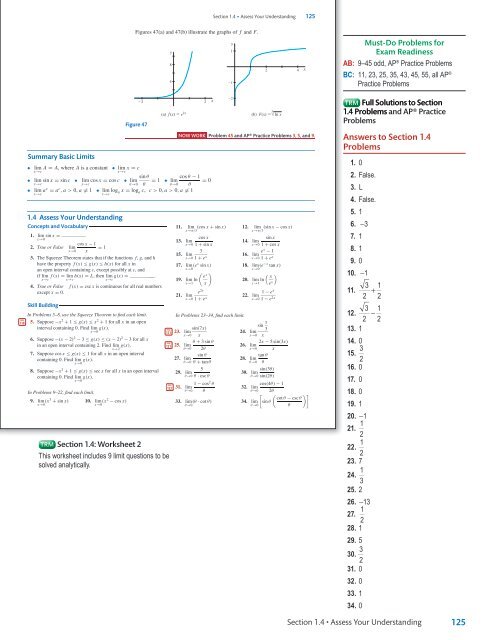Sullivan Microsite DigiSample
Create successful ePaper yourself
Turn your PDF publications into a flip-book with our unique Google optimized e-Paper software.
<strong>Sullivan</strong> AP˙<strong>Sullivan</strong>˙Chapter01 October 8, 2016 17:4<br />
Section 1.4 • Assess Your Understanding 125<br />
Figures 47(a) and 47(b) illustrate the graphs of f and F.<br />
y<br />
8<br />
4<br />
y<br />
1<br />
1<br />
2<br />
4<br />
x<br />
Must-Do Problems for<br />
Exam Readiness<br />
AB: 9–45 odd, AP ® Practice Problems<br />
BC: 11, 23, 25, 35, 43, 45, 55, all AP ®<br />
Practice Problems<br />
Summary Basic Limits<br />
• lim<br />
x→c<br />
A = A, where A is a constant<br />
• lim sin x = sin c • lim cos x = cos c<br />
x→c x→c<br />
• lim a x = a c , a > 0, a = 1<br />
x→c<br />
1.4 Assess Your Understanding<br />
Concepts and Vocabulary<br />
1. lim x→0<br />
sin x =<br />
Figure 47<br />
• lim<br />
x→c<br />
x = c<br />
2 2<br />
(a) f (x) e 2x<br />
sin θ<br />
cos θ − 1<br />
• lim = 1 • lim = 0<br />
θ→0 θ<br />
θ→0 θ<br />
• lim<br />
x→c<br />
log a x = log a c, c > 0, a > 0, a = 1<br />
cos x − 1<br />
2. True or False lim = 1<br />
x→0 x<br />
3. The Squeeze Theorem states that if the functions f, g, and h<br />
have the property f (x) ≤ g(x) ≤ h(x) for all x in<br />
an open interval containing c, except possibly at c, and<br />
if lim f (x) = lim h(x) = L, then lim g(x) = .<br />
x→c x→c x→c<br />
4. True or False f (x) = csc x is continuous for all real numbers<br />
except x = 0.<br />
Skill Building<br />
In Problems 5–8, use the Squeeze Theorem to find each limit.<br />
PAGE<br />
118 5. Suppose −x 2 + 1 ≤ g(x) ≤ x 2 + 1 for all x in an open<br />
interval containing 0. Find lim g(x).<br />
x→0<br />
6. Suppose −(x − 2) 2 − 3 ≤ g(x) ≤ (x − 2) 2 − 3 for all x<br />
in an open interval containing 2. Find lim x→2<br />
g(x).<br />
7. Suppose cos x ≤ g(x) ≤ 1 for all x in an open interval<br />
containing 0. Find lim x→0<br />
g(x).<br />
8. Suppose −x 2 + 1 ≤ g(x) ≤ sec x for all x in an open interval<br />
containing 0. Find lim x→0<br />
g(x).<br />
In Problems 9–22, find each limit.<br />
9. lim x→0<br />
(x 3 + sin x) 10. lim x→0<br />
(x 2 − cos x)<br />
x<br />
2<br />
3<br />
(b) F(x) ln x<br />
NOW WORK Problem 45 and AP® Practice Problems 3, 5, and 9.<br />
11. lim (cos x + sin x) 12. lim (sin x − cos x)<br />
x→π/3 x→π/3<br />
13.<br />
cos x<br />
sin x<br />
lim<br />
14. lim<br />
x→0 1 + sin x<br />
x→0 1 + cos x<br />
15.<br />
3<br />
e x − 1<br />
lim x→0 1 + e x 16. lim x→0 1 + e x<br />
17. lim(e x sin x) 18. lim(e −x tan x)<br />
x→0 x→0<br />
( ) e x<br />
( x<br />
)<br />
19. lim ln<br />
20. lim ln<br />
x→1 x<br />
x→1 e x<br />
e 2x<br />
1 − e x<br />
21. lim x→0 1 + e x 22. lim x→0 1 − e 2x<br />
In Problems 23–34, find each limit.<br />
PAGE<br />
121 23.<br />
sin(7x)<br />
lim x→0 x<br />
PAGE<br />
121 25.<br />
θ + 3 sin θ<br />
lim θ→0 2θ<br />
27.<br />
sin θ<br />
lim θ→0 θ + tan θ<br />
29.<br />
5<br />
lim θ→0 θ · csc θ<br />
PAGE<br />
122 31.<br />
1 − cos 2 θ<br />
lim θ→0 θ<br />
24. lim x→0<br />
sin x 3<br />
x<br />
26.<br />
2x − 5 sin(3x)<br />
lim x→0 x<br />
28.<br />
tan θ<br />
lim θ→0 θ<br />
30.<br />
sin(3θ)<br />
lim θ→0 sin(2θ)<br />
[<br />
33. lim(θ · cot θ) 34. lim sin θ<br />
θ→0 θ→0<br />
cos(4θ)− 1<br />
32. lim θ→0 2θ<br />
( )]<br />
cot θ − csc θ<br />
θ<br />
TRM Full Solutions to Section<br />
1.4 Problems and AP® Practice<br />
Problems<br />
Answers to Section 1.4<br />
Problems<br />
1. 0<br />
2. False.<br />
3. L<br />
4. False.<br />
5. 1<br />
6. −3<br />
7. 1<br />
8. 1<br />
9. 0<br />
10. −1<br />
3 1<br />
11. +<br />
2 2<br />
3 1<br />
12. −<br />
2 2<br />
13. 1<br />
14. 0<br />
15. 3 2<br />
16. 0<br />
17. 0<br />
18. 0<br />
19. 1<br />
20. −1<br />
21. 1 2<br />
TRM Section 1.4: Worksheet 2<br />
This worksheet includes 9 limit questions to be<br />
solved analytically.<br />
22. 1 2<br />
23. 7<br />
24. 1 3<br />
25. 2<br />
26. −13<br />
27. 1 2<br />
28. 1<br />
29. 5<br />
30. 3 2<br />
31. 0<br />
32. 0<br />
33. 1<br />
34. 0<br />
Section 1.4 • Assess Your Understanding<br />
125<br />
TE_<strong>Sullivan</strong>_Chapter01_PART II.indd 8<br />
11/01/17 9:55 am




